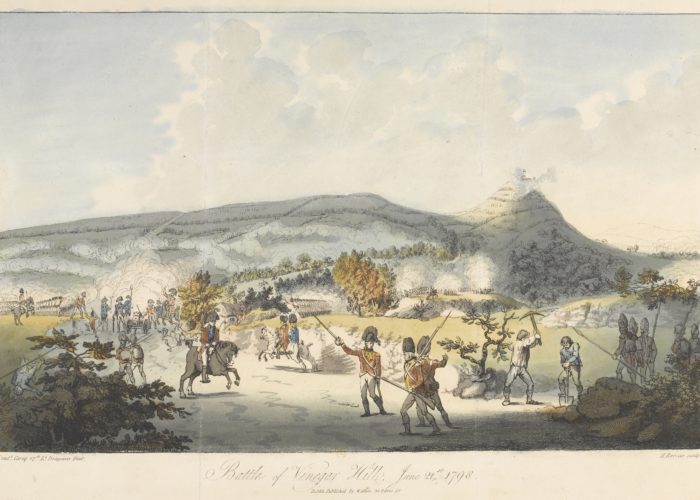The Battle of Vinegar Hill (1798)
Theme: Ireland's uprising (1798), War and the international order
The uprising in Ireland, in 1798, was a major rebellion against colonial British rule. It was led by the United Irishmen – a mixed group of Protestant and Catholic radicals. The Battle of Vinegar Hill, as it became known, in County Wexford in the southeast of Ireland, was the last major engagement between the United Irishmen and the British military and marked a significant turning point in the rebellion.
The Society of United Irishmen was an initially peaceful organisation founded in late 1791 which, eventually, aimed to establish Ireland as an independent republic – free from British rule. Inspired by the French Revolution and the writings of Thomas Paine, they began to organise an uprising to overthrow the British Crown. By 1798 preparations seemed complete and promises of support from the French Republic’s troops had been secured.
The plan was to take Dublin (where the Irish Parliament was situated), while the surrounding counties provided support by preventing British troops from entering the city. However, the British were tipped off by spies and took countermeasures before the United Irishmen could fully prepare to fight. There were heavy casualties and many of the leaders were arrested. The remaining United Irishmen either abandoned or were forced to attempt the planned insurrection, which spread across the country without assistance from the French, who had yet to arrive.
Conflict erupted in the counties around Dublin in a series of bloody battles and horrific massacres. Both sides engaged in the killing of civilians and widespread looting. The United Irishmen’s rebellion rapidly spread south, and, on 30 May they took the important military stores in Wexford and briefly gained control of the city. But without the support of the French, the British forces and loyalists were able to recover and reorganise. The United Irishmen were eventually defeated at Vinegar Hill on 21 June.
The Battle of Vinegar Hill largely destroyed the armies of the United Irishmen, although complete annihilation was avoided when British troops failed to secure the Slaney bridge. This allowed large numbers of the United Irishmen (and the women and children with them) to escape atrocities, but it did force a break-up of the force and encouraged a shift to mobile warfare and guerrilla tactics. By the time a small French force finally landed in Ireland, on 23 August, the uprising was over and the French were quickly forced to surrender.
This image depicts the battle fought between the Government soldiers of the British Army of Ireland and the rebel soldiers of the United Irishmen on the 21st June 1798.
Did you know..?
The battle was actually fought in two locations: on Vinegar Hill itself and in the streets of nearby Enniscorthy.
Use our Education activities to investigate this object and Ireland’s 1798 uprising further.
Highlights:
And much more…
Sources & acknowledgement
This object description and its related educational resources were researched and written by our team of historians and education specialists. For further information see the item’s home museum, gallery or archive, listed above.
- Related resources
-
Did you know..?
The battle was actually fought in two locations: on Vinegar Hill itself and in the streets of nearby Enniscorthy.
-
Education overview
You can access a range of teachers resources related to this object and more on our education page.
Please also see our glossary of terms for more detailed explanations of the terms used.
-
Curatorial info
- Originating Museum: National Army Museum
- Accession Number: NAM. 1971-02-33-411-1
- Production Date: c.1798
- Creator: Henry Brocas
- Original record
-
Use this image
You can download this image for personal and educational use but please take note of the license type and rights holder information.
- Rights Holder: National Army Museum
- License Type:



